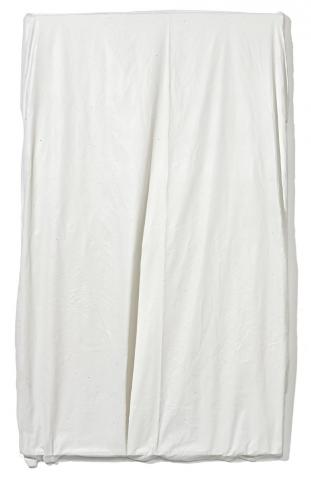COVER UP # 1, 2012
CALLUM MORTON
polyurethane resin, wood, synthetic polymer paint
200.0 x 118.0 x 10.0 cm
Roslyn Oxley9 Gallery, Sydney
Private collection, Sydney
Callum Morton: The Insides 2012, Roslyn Oxley9 Gallery, Sydney, June - July 2012
Cover Up # 4, 2012, synthetic polymer paint on resin, polyurethane and composition board, 190.0 x 110.5 cm, collection of the National Gallery of Victoria, Melbourne, illus. in Melbourne Now, National Gallery of Victoria, Melbourne, 2013, p. 170
Belonging to a series of works created in 2012, Cover Up # 1 is a large sculpture shaped in the form of a painting, seemingly covered by a sheet in an effort to conceal the work underneath. At first glance, the sculpture is incredibly lifelike and the viewer is tempted to pull off the shroud and reveal the hidden secret. But on closer inspection it becomes apparent that the focus of the work is not the painting, it is the cover up. The plain white sheet alludes to vacated homes, abandonment, and forgotten and outdated objects from a bygone era. Meanwhile, the theatrical element of this work is reminiscent of Rene Magritte's small group of paintings of unidentified figures, whose faces are mysteriously shrouded by white cloth. We are also reminded of Mel Ramsden's mysterious Secret Painting, 1967-68, a black canvas accompanied by a text which states that the contents of the canvas are a complete secret and known only to the artist.1
Unlike many of Morton's other sculptures, models and prints which create a visual tension between architecture and consumerism, the Cover Up series is seemingly devoid of any commentary on commercial branding. Yet Morton's discourse is still evident in these less obvious works. Cover Up # 1 is depicted as a covered Willem de Kooning painting, while a shrouded chair from the same exhibition Cover Up # 2 represents a popular Eames design, both famous icons of the twentieth century.2 Morton has removed the visual content and narrative from these two objects and has remade them in a new context.
Morton is renowned for his architectural sculptures, installations and prints, however the significant group of Cover Up sculptures elucidates the role of objects within the structural design. As a former student of architecture, construction and design has always played a strong role in Morton's works. His oeuvre investigates the utopian ideals of architecture against the stark reality of urbanisation, social conflict and politics. Many of his works illustrate familiar designs of glamorous buildings but with a certain foreboding undertone, or dilapidated ruins of once glorified buildings, illuminating the role of architecture in society's collapse. By discussing the issue of 'globalisation-sustaining lifestyles of the so-called West,'3 Morton's commentary upon Western society is provocative and relevant.
Cover Up # 1 was first exhibited at Roslyn Oxley9 Gallery in Sydney in 2012. A second show featuring several shrouded 'canvases' and one small object, was shown later that year at Anna Schwartz Gallery, Melbourne. Cover Up # 4 from the latter show was recently exhibited in the Melbourne Now exhibition held at The National Gallery of Victoria, Melbourne. Morton represented Australia at the Venice Biennale in 2007 and his works are held in the major public collections across Australia. A site-specific installation is currently included in the 19th Biennale of Sydney, You Imagine What You Desire.
1. Anna Schwartz Gallery website <http://www.annaschwartzgallery.com/works/artist_exhibitions?artist=8&year=2012&work=&exhibition=400&page=1&text=1&c=m> viewed 19 March 2014
2. Roslyn Oxley9 Gallery website <http://www.roslynoxley9.com.au/news/releases/2012/06/23/217/> viewed 19 March 2014
3. Scott, F., 'Callum Morton: Unsettlement' in Day, C., and Tutton, S., (eds), Before and After Science: 2010 Adelaide Biennial of Australian Art, Art Gallery of South Australia, Adelaide, 2010, p. 66
CASSI YOUNG
